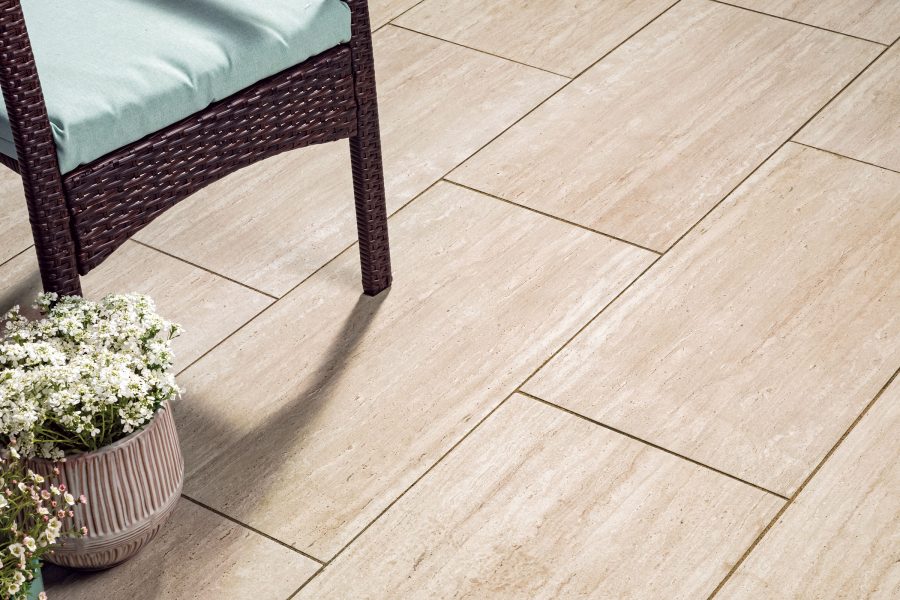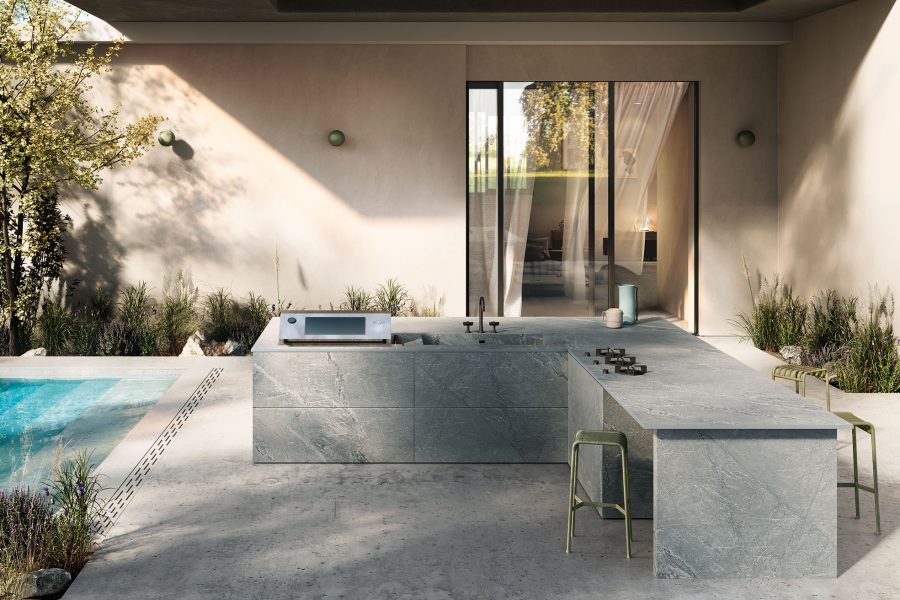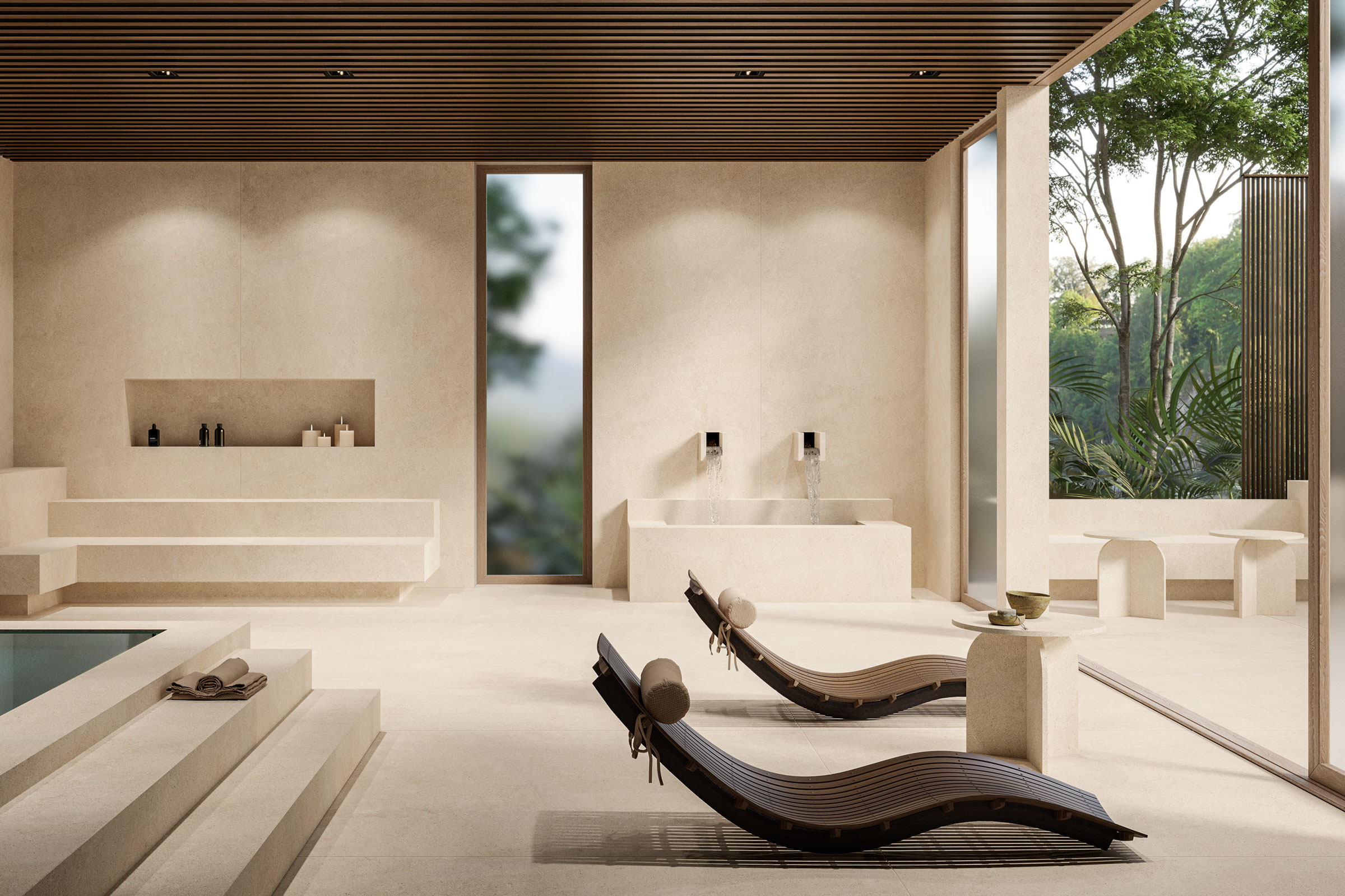Story at a glance:
- Porcelain pavers can give an outdoor space a high-end look without a lot of challenges.
- The benefits of porcelain include durability, stain resistance, and easy cleaning.
When design calls for a luxe, high-end look, materials like marble and travertine can be good choices for indoor flooring. But when that same luxurious look is the goal for an outdoor space, those materials don’t work as well.
Porcelain pavers can be an ideal choice to give outdoor spaces a high-end feel. “It’s a way to bring the appearance of natural materials to areas where the natural materials wouldn’t work,” says Brent Bevenour, who leads technical sales for granite and porcelain at Pennsylvania-based Hanover Architectural Products.
A Guide to Porcelain Pavers

Hanover offers five porcelain paver collections, with options that mimic the look of materials like bluestone, travertine (seen here), marble, and limestone without the problems that come with using them outdoors. Photo courtesy of Hanover
Porcelain pavers are made from a blend of natural materials like clay, sand, and minerals like feldspar. The mixture is shaped into the desired form, then kiln-fired at extremely high temperatures to create a product that’s dense and durable.
Hanover offers five porcelain paver collections, with options that mimic the look of materials like bluestone, travertine, marble, and limestone without the problems that come with using them outdoors. Travertine, for example, is an extremely porous material, which is not ideal for dealing with precipitation or staining in an outdoor environment.
Porcelain pavers have very low water absorption and won’t get stained by oil, food, or other substances.
“You’re talking less than a 100th of a percent absorption in these materials, so nothing’s penetrating them to stain them,” Bevenour says.
And no harsh chemicals are needed to clean them. “In almost every single instance you can just use warm water with a rag and wipe all the material off of them.” That includes things like moss that can build up in outdoor spaces. “The moss can’t stick to those pavers,” Bevenour says. “It’s just a broom clean or hosing things off.”
Porcelain pavers are also scratch- and UV-resistant. And they’re a sustainable choice, because they’re made from readily available materials and have good longevity. “We’re talking years and years and years,” Bevenour says. “We’re having 50-, 60-, 70-year life cycles on these pavers.”
Optimum Surfaces XL Porcelain Slabs

Optimum’s extra-large slabs minimize the number of joints needed, which reduces the spread of germs and bacteria and makes cleaning easier. The size of the slabs also helps minimize the waste that often occurs during cutting. Photo courtesy of Hanover
Hanover recently began offering Optimum Surfaces Porcelain Slabs—the largest porcelain slabs available on the market, measuring 72.5-by-130 inches and sized for efficiency and minimizing waste. The company expects them to be a popular choice for indoor applications like kitchens and baths as well as for outdoor spaces where clients want a cohesive indoor-outdoor look without seams.
“It allows you to have the same indoor and outdoor kind of flow because it’ll be matching,” says Luke Lardarello, who leads technical sales for Optimum Surfaces at Hanover. “Whereas if you wanted to do something with a quartz, you wouldn’t want to put a quartz outside because it’s going to stain easier. It’s not UV-resistant; it’s not-heat resistant.
“The opportunities are endless,” he continues. “We’re able to get a very good-looking natural stone look with a sustainable porcelain product.”
Sustainable Solutions
- Hanover recently launched two new colors for outdoor porcelain pavers—bamboo (seen here) and redwood. Photo courtesy of Hanover
- Interest in porcelain products has been increasing for both residential and commercial outdoor spaces. Photo courtesy of Hanover
That sustainability factor is taken up a notch since the Optimum slabs are produced in Italy in a new, state-of-the-art facility that focuses on conserving energy throughout production. In general, the process for producing porcelain slabs is much less disruptive than what it takes to produce slabs of marble or other materials.
“Your typical marble or granite takes 100 million years to get its look and its shape and its hardness,” Lardarello says. “Optimum actually does this process in two days. There’s not going to be any ecosystem decline or habitat loss because all of the materials inside of the porcelain are clay, sand, feldspar. You’re not going to the top of mountains and taking off the side of a mountain and using heavy equipment and destroying ecosystems. There’s a lot of sand in the world; there’s a lot of clay deposits in the world.”
There are very few drawbacks to opting for porcelain in outdoor spaces, he says. The only thing people really need to consider? Color. “If you’re using a dark color in a sunny area, the material is going to get warm,” Bevenour says. “But that’s the same with concrete and stone. With basically any material you put outside, color matters. So lighter colors certainly work better.”
Increased Demand
Interest in porcelain products has been increasing for both residential and commercial outdoor spaces.
“People are liking the finishes, the colors, that upscale option,” Bevenour says. “You see it in a lot of multi-use residential family complexes for amenity spaces. You see it at a lot of high-end restaurants. You see it at hotels. You’re seeing it at these hospitality-type places that want that higher-end finish.”
But education about the material is still needed, especially when it comes to questions about quality. “Not all porcelain is the same, and the quality of that porcelain says a lot about how well it’s going to perform,” Bevenour says.
If pavers break easily, that’s not a quality product. “You’re dealing with something that’s more of a ceramic, a lower-level ceramic than a higher-quality porcelain,” Bevenour says. “So there’s always quelling that fear.”
Listening to customers helps Hanover continue to innovate and address needs in the marketplace. “You need to be able and willing to listen to the feedback your customers give you,” Bevenour says. “If you aren’t willing to hear that and aren’t willing to listen to some of the input they have, you can’t stay ahead of things. If what they’re constantly requesting is something you can’t offer, the question is, why can’t you offer it?”
With the addition of Optimum Surfaces Porcelain Slabs to its offerings, Hanover feels well-positioned to create functional and beautiful spaces indoors and out. “I’m definitely looking forward to seeing where the porcelain paving paired with Optimum can take the porcelain market for interior and exterior, for that indoor-outdoor living,” Bevenour says. “I’m interested to see where that can go.”



